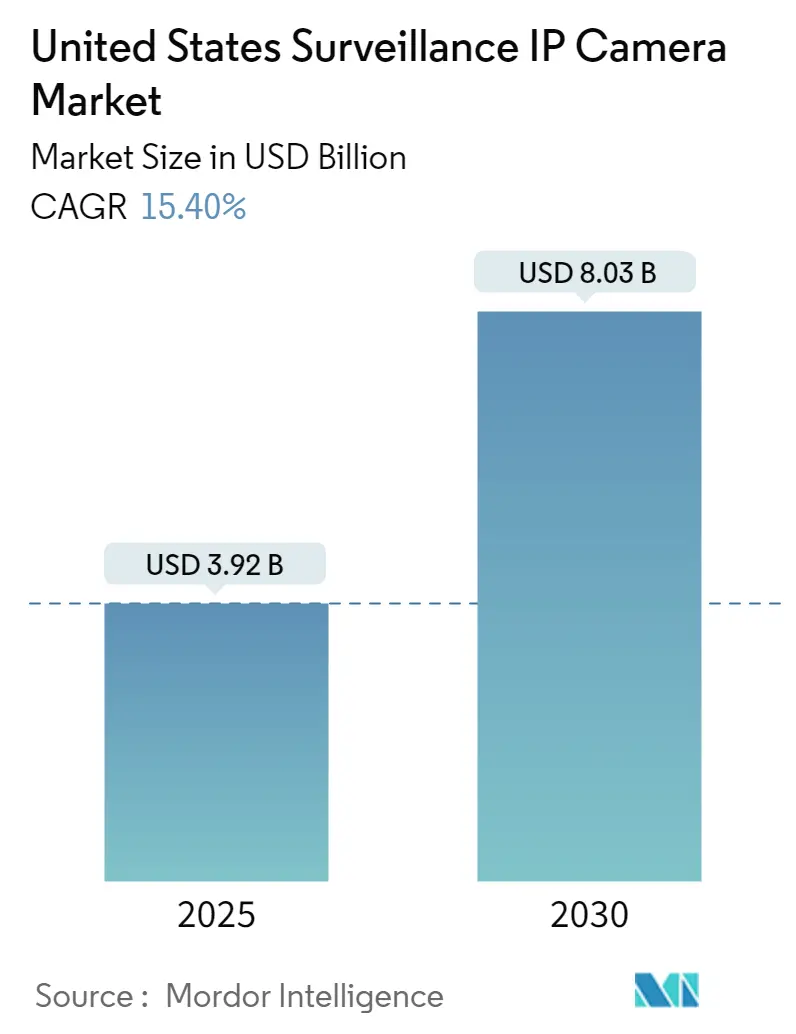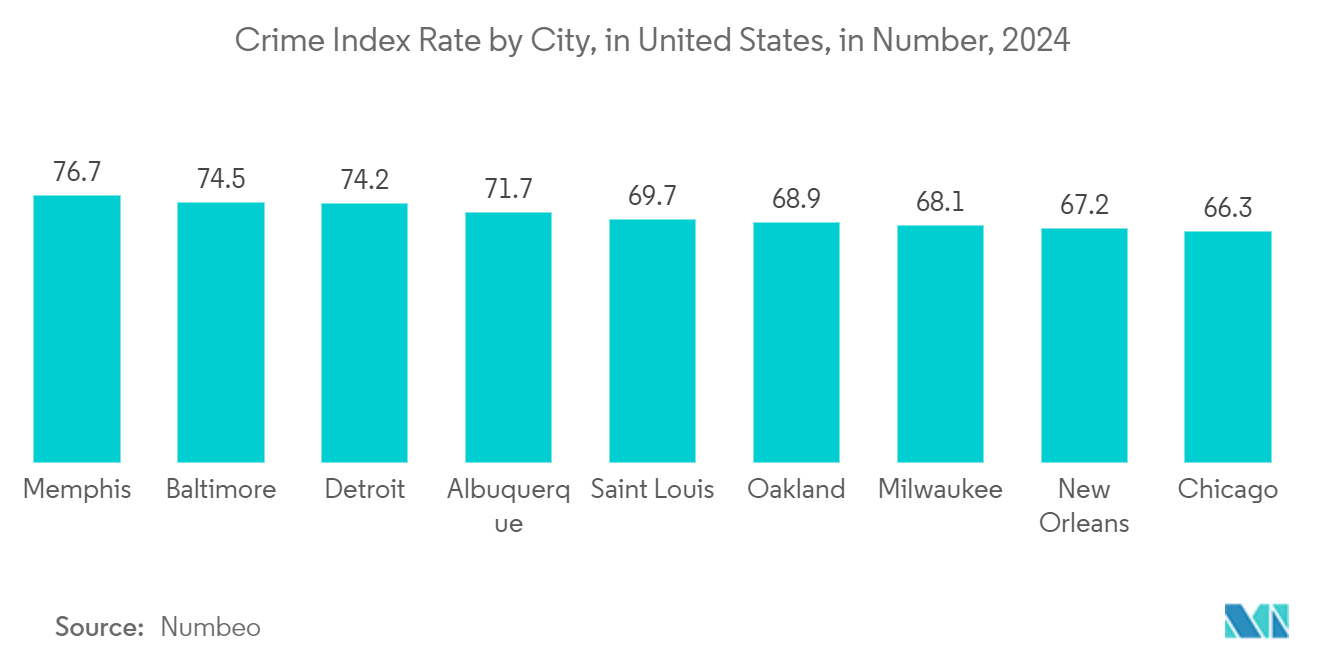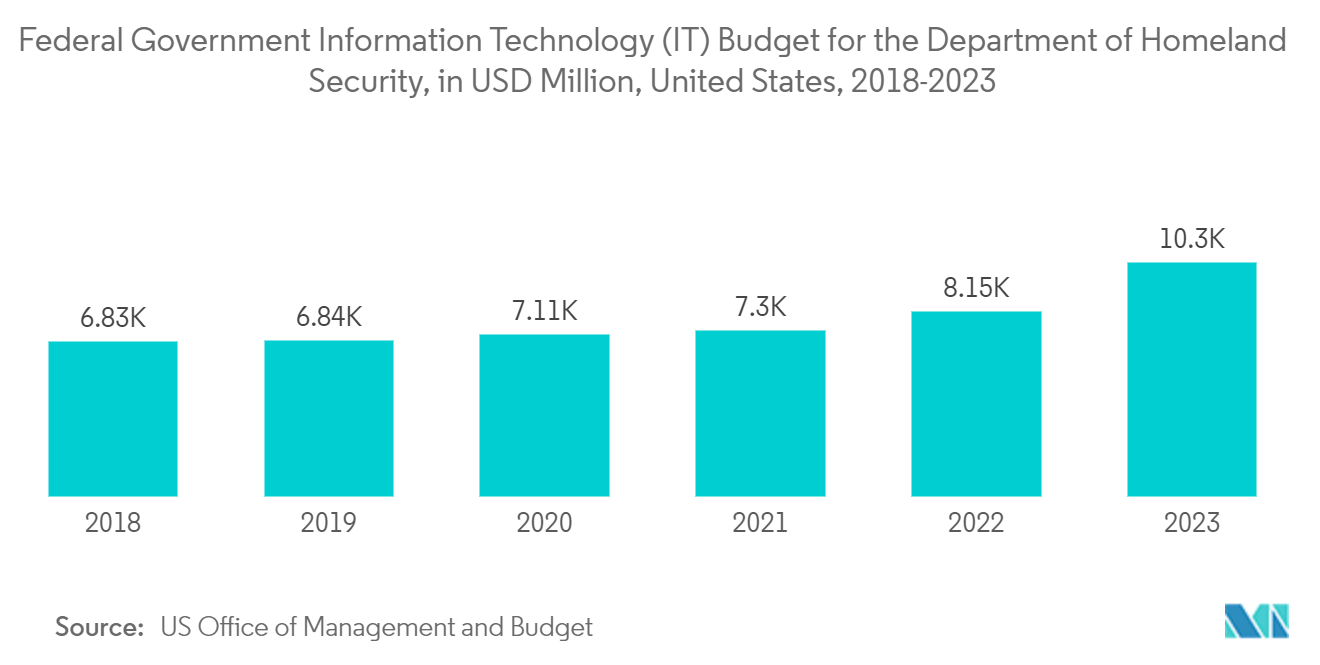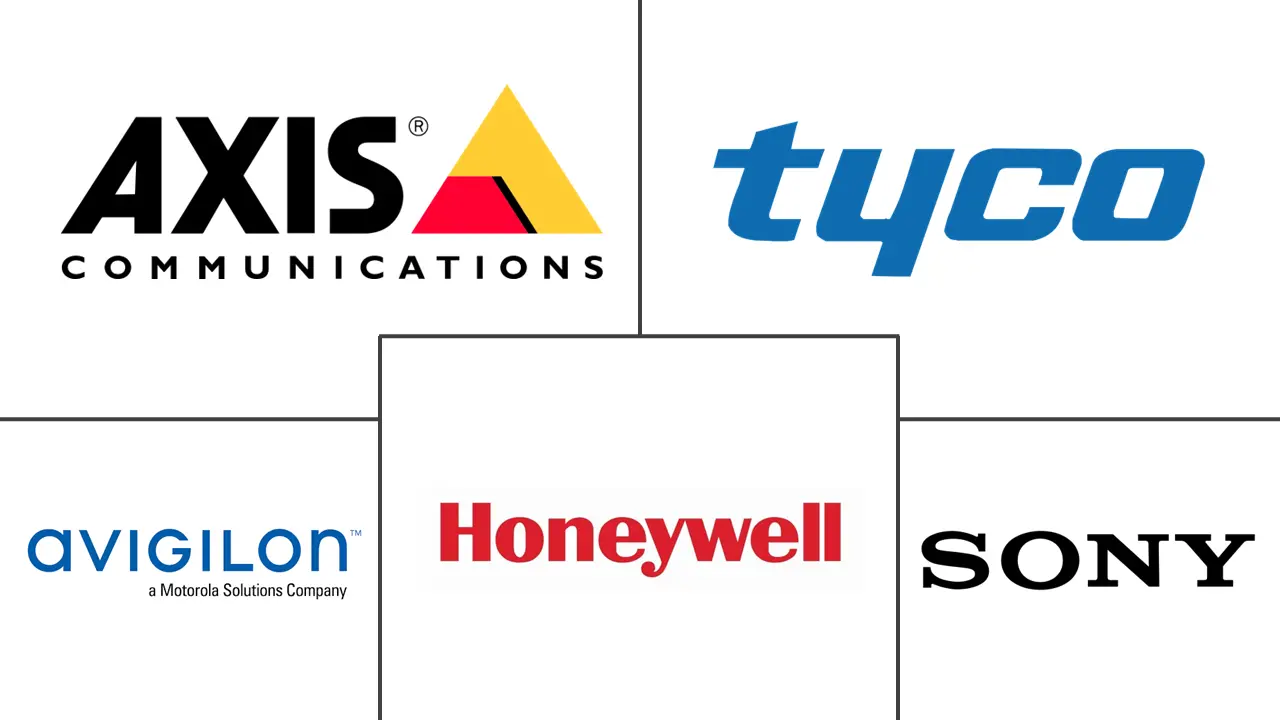United States Surveillance IP Camera Market Size and Share

United States Surveillance IP Camera Market Analysis by Mordor Intelligence
The United States Surveillance IP Camera Market size is estimated at USD 3.92 billion in 2025, and is expected to reach USD 8.03 billion by 2030, at a CAGR of 15.4% during the forecast period (2025-2030).
- As numerous analog CCTV systems in the United States near the end of their operational life, the demand for their replacement with IP-based surveillance cameras is surging. IP cameras boast superior features, including heightened video resolution, enhanced image quality, remote accessibility, and seamless integration with diverse security setups. This shift is being hastened by the decreasing costs of IP cameras and the rise of sophisticated video management software.
- US government entities, law enforcement, and operators of critical infrastructure are channeling investments into cutting-edge surveillance solutions amid escalating crime rates, terrorism concerns, and natural calamities. Surveillance IP cameras, armed with features like video analytics, facial recognition, and license plate identification, are witnessing widespread adoption. Their deployment aims to bolster threat detection, streamline incident responses, and elevate public safety. The imperative for robust surveillance systems is most pronounced in high-stakes locales, including airports, transportation hubs, government skyscrapers, and major public gatherings.
- Many US municipalities are rolling out smart city initiatives, harnessing the capabilities of surveillance IP cameras for diverse applications. These range from traffic management and parking optimization to environmental monitoring and bolstering public safety. These endeavors stem from a shared goal to refine urban planning, enhance resource allocation, and elevate residents' quality of life. By meshing IP cameras with cutting-edge analytics, robust data platforms, and centralized command hubs, city administrations are empowered to craft data-centric strategies and fine-tune municipal operations.
- However, rising connectivity between IP cameras and their integration with broader security and IT systems have heightened worries about cybersecurity vulnerabilities. In the United States, end users are notably anxious about the risks of cyber attacks, data breaches, and unauthorized system access.
- Macroeconomic factors such as income levels, demographic shifts, and cultural inclinations play a pivotal role in shaping the demand for surveillance IP cameras. In 2023, the United States saw a notable rise in its GDP, climbing from USD 33.58 trillion in 2022 to USD 34.95 trillion, as reported by the International Monetary Fund (IMF). This economic strength in the United States is poised to positively influence the trajectory of the market studied.
United States Surveillance IP Camera Market Trends and Insights
Increasing Focus on Public Safety and Security is Expected to Drive the Market
- In the United States, a surge in mass shootings, terrorist attacks, and other high-profile violent incidents has amplified public safety concerns. As per the Numbeo crime index rate, Memphis, a city in the United States, holds the highest number at 76.7, which is concerning. Consequently, there is a growing appetite for cutting-edge surveillance technologies, notably IP cameras. These are increasingly deployed to oversee public areas, transportation centers, and vital infrastructure.
- The US law enforcement agencies and intelligence organizations are swiftly embracing surveillance IP camera systems. These systems are pivotal in investigations, evidence collection, and immediate incident responses. These cameras significantly bolster the operational prowess of law enforcement equipped with advanced analytics and facial recognition.
- Through initiatives like the SAFETY Act, the US government is actively encouraging the adoption of advanced security technologies, notably surveillance IP cameras. This push is particularly felt in critical infrastructure sectors, where private entities invest in IP camera systems to adhere to regulations and bolster their security measures.
- Advancements in video analytics, spanning from facial recognition to behavior analysis, have significantly bolstered the capabilities of surveillance IP cameras. This enhancement in functionality has not only improved threat detection but also played a pivotal role in elevating public safety. Consequently, the rising integration of these sophisticated features fuels the demand for IP camera solutions across the US market.

Government End-user Industry is Expected to Hold a Significant Market Share
- With the mounting threats of terrorism, civil unrest, and cybersecurity breaches, federal governments are under heightened scrutiny to bolster security measures. Surveillance IP cameras have emerged as pivotal tools in this landscape, safeguarding government facilities, public areas, and critical infrastructure.
- Regulations and guidelines in the United States compel governments to deploy surveillance systems, covering areas like physical security, video evidence collection, and meeting security standards. Compliance with these mandates is a pivotal factor propelling the uptake of surveillance IP cameras in government and public sector entities.
- Both the federal and state governments in the United States are channeling substantial budgets into bolstering security and public safety, notably through investments in surveillance technologies. As per the US Office of Management and Budget, in 2024, the US federal government has earmarked approximately USD 74 billion for its civilian federal agency information technology budget. Notably, the IT budget for the Department of Homeland Security surged to USD 10.296 billion in 2023, marking a substantial increase of over USD 8.15 billion from the preceding year. This surge in funding in IT for homeland security can be a key driver propelling the growth of the surveillance IP camera market within the government sector.
- Government bodies are pivoting toward centralized command centers. These centers amalgamate various security systems, notably surveillance IP cameras. The goal is to enhance situational awareness, streamline incident responses, and bolster security management. This shift toward integrated security solutions is propelling the uptake of IP-based camera systems, which are prized for their ability to mesh harmoniously with other elements of a security setup.

Competitive Landscape
The US surveillance IP camera market is highly competitive, with several global and local players. To remain competitive, the major players emphasize product innovation, partnerships, collaborations, mergers, and acquisitions. Some of the major players in the market studied are Honeywell Security, Avigilon Corporation, Tyco (a Johnson Controls Brand), Axis Communications AB, and Sony Corporation.
- April 2024: Sony unveiled its latest flagship camera, the BRC-AM7, boasting a 4K 60p resolution and pan-tilt-zoom (PTZ) capabilities. Its integration of PTZ Auto Framing technology, harnessing AI for precise subject tracking, is noteworthy. This feature promises a seamless, lifelike tracking experience. These advancements streamline video production, particularly for broadcast, live events, and sports. The BRC-AM7 is both IP and free-d compatible, aligning with modern video production needs.
- April 2024: Axis Communications unveiled a robust 4K bullet camera, emphasizing image quality and ultra-high light sensitivity. With features like PoE, it simplifies connecting and powering additional devices without extra cabling. This camera enhances its processing prowess, enabling more extensive data collection and analysis directly on the device with a deep learning processing unit. Moreover, it provides valuable metadata, streamlining forensic searches for swift and efficient results.
United States Surveillance IP Camera Industry Leaders
-
Honeywell Security (Honeywell International Inc.)
-
Avigilon Corporation
-
Tyco (A Johnson Controls Brand)
-
Axis Communications AB
-
Sony Corporation
- *Disclaimer: Major Players sorted in no particular order

Recent Industry Developments
- April 2024: Zhejiang Dahua Technology recently finalized the sale of its US subsidiary, marking a significant step in its divestment from the US market. This move comes after a string of sanctions imposed on the company over the years. Dahua confirmed it has successfully offloaded all its shares in Dahua Technology USA. The purchasing entity, Central Motion Picture USA, acquired the shares for USD 15 million. As part of the deal, inventory products valued at USD 1 million from Dahua's Canadian arm were also transferred to the buyer.
- October 2023: Lorex Technology unveiled its newest product, the 4K Dual Lens Wi-Fi Security Camera. This camera offers an innovative design: it houses two professional-grade lenses, delivering a panoramic 180° view in authentic 4K resolution. These dual lenses utilize Image Stitching Technology positioned adjacent to each other. This technology seamlessly merges two scenes, empowering users to surveil expansive areas with just one camera.
United States Surveillance IP Camera Market Report Scope
IP cameras are digital video cameras that operate within a network. These cameras, being entirely digital, rely on Cat5 networking cables for connectivity. They deliver impressive video quality, from HD at 1080p to 4K. IP cameras have become critical players in the surveillance market, providing businesses with a reliable security solution. Their features include high resolutions, remote monitoring capabilities, scalability, and advanced analytics, all placing IP cameras at the forefront of the surveillance industry. The market size is gauged by the sales of IP camera products across various sectors, with the study also delving into the market's growth patterns and macroeconomic influencers.
The US surveillance IP camera market is segmented by end-user industry (government, banking, healthcare, transportation, logistics, industrial, and other end-user industries [education institutions, retail, and enterprises]). The report offers market forecasts and size in value (USD) for all the above segments.
| Government |
| Banking |
| Healthcare |
| Transportation and Logistics |
| Industrial |
| Other End-user Industries (Education Institutions, Retail, and Enterprises) |
| By End-user Industry | Government |
| Banking | |
| Healthcare | |
| Transportation and Logistics | |
| Industrial | |
| Other End-user Industries (Education Institutions, Retail, and Enterprises) |
Key Questions Answered in the Report
How big is the United States Surveillance IP Camera Market?
The United States Surveillance IP Camera Market size is expected to reach USD 3.92 billion in 2025 and grow at a CAGR of 15.40% to reach USD 8.03 billion by 2030.
What is the current United States Surveillance IP Camera Market size?
In 2025, the United States Surveillance IP Camera Market size is expected to reach USD 3.92 billion.
Who are the key players in United States Surveillance IP Camera Market?
Honeywell Security (Honeywell International Inc.), Avigilon Corporation, Tyco (A Johnson Controls Brand), Axis Communications AB and Sony Corporation are the major companies operating in the United States Surveillance IP Camera Market.
What years does this United States Surveillance IP Camera Market cover, and what was the market size in 2024?
In 2024, the United States Surveillance IP Camera Market size was estimated at USD 3.32 billion. The report covers the United States Surveillance IP Camera Market historical market size for years: 2019, 2020, 2021, 2022, 2023 and 2024. The report also forecasts the United States Surveillance IP Camera Market size for years: 2025, 2026, 2027, 2028, 2029 and 2030.
Page last updated on:
United States Surveillance IP Camera Market Report
Statistics for the 2025 United States Surveillance IP Camera market share, size and revenue growth rate, created by Mordor Intelligence™ Industry Reports. United States Surveillance IP Camera analysis includes a market forecast outlook for 2025 to 2030 and historical overview. Get a sample of this industry analysis as a free report PDF download.



